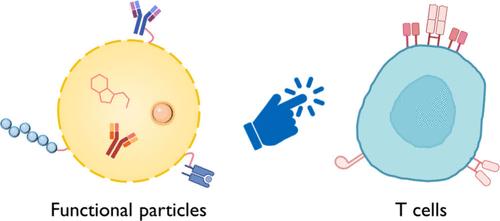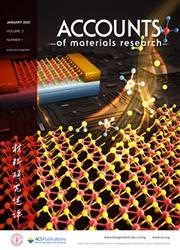Engineering Functional Particles to Modulate T Cell Responses
IF 14
Q1 CHEMISTRY, MULTIDISCIPLINARY
引用次数: 0
Abstract
T cells play a critical role in adaptive immune responses. They work with other immune cells such as B cells to protect our bodies when the first line of defense, the innate immune system, is overcome by certain infectious diseases or cancers. Studying and regulating the responses of T cells, such as activation, proliferation, and differentiation, helps us understand not only their behavior in vivo but also their translation and application in the field of immunotherapy, such as adoptive T cell therapy and immune checkpoint therapy, the situations in which T cells cannot fight cancer alone and require external engineering regulation to help them. Nano- to micrometer-sized particulate biomaterials have achieved great progress in the assistance of T cell-based immunomodulation. For example, various types of microparticles decorated with T cell recognition and activation signals to mimic native antigen-presenting cells have shown successful ex vivo expansion of primary T cells and have been approved for clinical use in adoptive T cell therapy. Functional particles can also serve as vehicles for transporting cargos including small molecule drugs, cytokines, and antibodies. Especially for cargos with limited bioavailability and high repeat-dose toxicity, systemic administration in their free form is difficult. By using particle-assisted systems, the delivery can be tailored on demand, of which targeting and controlled release are two typical examples, ultimately aiding in the regulation of T cell responses. Furthermore, when T cells become overactive and behave in ways that contradict our expectations, such as attacking our own cells or innocuous foreign molecules, this can lead to a breakdown of immune tolerance. In such cases, particles to help reprogram those overactive T cells or suppress their activity are appreciated in vivo. The urgent need to introduce immune stimulation into the treatment of cancers, infectious diseases, and autoimmune diseases has driven recent advances in the engineering of functional particulate biomaterials that regulate T cell responses. In this Account, we will first cover a brief overview of the process of T cell-based immunomodulation from principle to development. It then outlines critical points in the design of functional particle platforms, including materials, size, morphology, surface engineering, and delivery of cargos, to modulate the features of T cells, and introduces selected work from our and other research groups with a focus on three major therapeutic applications: adoptive T cell therapy, immune checkpoint therapy, and immune tolerance restoration. Current challenges and future opportunities are also discussed.

用工程学功能颗粒调节 T 细胞反应
T 细胞在适应性免疫反应中起着至关重要的作用。当第一道防线--先天性免疫系统--被某些传染病或癌症攻破时,T 细胞与 B 细胞等其他免疫细胞一起保护我们的身体。研究和调控 T 细胞的活化、增殖和分化等反应,不仅有助于我们了解它们在体内的行为,还有助于我们了解它们在免疫疗法领域的转化和应用,如收养 T 细胞疗法和免疫检查点疗法,在这些疗法中,T 细胞无法单独对抗癌症,需要外部工程调控来帮助它们。纳米到微米级的微粒生物材料在辅助基于 T 细胞的免疫调节方面取得了重大进展。例如,用 T 细胞识别和活化信号装饰的各种微粒可模拟原生抗原递呈细胞,成功实现了原生 T 细胞的体内外扩增,并已获准用于临床的 T 细胞收养疗法。功能性微粒还可以作为运输载体,运输小分子药物、细胞因子和抗体等载体。特别是对于生物利用度有限且重复剂量毒性较高的载体,很难以游离形式进行全身给药。通过使用颗粒辅助系统,可以按需给药,其中靶向和控释就是两个典型的例子,最终有助于调节 T 细胞的反应。此外,当 T 细胞过度活跃并表现出与我们的期望相悖的行为时,例如攻击自身细胞或无害的外来分子,就会导致免疫耐受的崩溃。在这种情况下,我们需要在体内使用微粒来帮助这些过度活跃的 T 细胞重新编程或抑制它们的活性。在癌症、传染病和自身免疫性疾病的治疗中引入免疫刺激的迫切需要,推动了调节 T 细胞反应的功能性微粒生物材料工程学的最新进展。在本讲座中,我们将首先简要介绍基于 T 细胞的免疫调节从原理到开发的过程。然后概述功能性微粒平台设计的关键点,包括材料、尺寸、形态、表面工程和载体递送,以调节 T 细胞的特征,并介绍我们和其他研究小组的部分工作,重点关注三大治疗应用:T 细胞收养疗法、免疫检查点疗法和免疫耐受恢复。此外还讨论了当前的挑战和未来的机遇。
本文章由计算机程序翻译,如有差异,请以英文原文为准。
求助全文
约1分钟内获得全文
求助全文

 求助内容:
求助内容: 应助结果提醒方式:
应助结果提醒方式:


